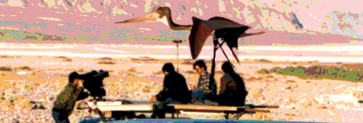
By Ray Morgan
Nobody wishes for misfortune or accidents, but if you’re not too proud, and you understand that plenty of great developments stem from a botched plan or someone’s initial missteps, you begin to look for growth potential in accidents too.
On the Pathfinder solar-powered airplane project, we found that the application of procedures could allow a relatively fragile aircraft to operate safely in the stratosphere. In September 1995, we set a world altitude record for solar aircraft of 50,500 feet at Edwards Air Force Base. However, we had assumed that when the airplane was in a hangar on the ground, it was inherently safe and we didn’t need to worry about procedures for its safety. We were shocked out of this assumption fairly dramatically.
In October we were asked to display the Pathfinder at the Edwards air show, where it would be parked in a hangar near two classified aircraft, the B-2 and an F-117. Because these two aircraft were still classified and under armed guard, they were brought in at night, after all the other aircraft had been placed in the hangar, and were removed in the same fashion.
Our crew chief told the attendant in charge during the day (when we brought the Pathfinder in) that our plane was much more fragile than these others and that he needed to be extra careful when moving it or moving the other planes around it. He particularly emphasized the Pathfinder’s susceptibility to wind, because it was so large and light (100 feet in span, but weighing less than 500 lbs.). The hangar guardian seemed quite responsible, and we had no reason to doubt he would do anything less than what we asked. All went well, until the show ended.
During the night some other Air Force guys came by to move the B-2 and the F-117 to a different hangar. The guy we talked with about our plane wasn’t there and hadn’t talked to these guys. They left the hangar doors open on 3 sides, and that night there was a windstorm that exceeded 30 knots (so strong it blew over the portable toilets). With all three doors open, the hangar became a giant wind tunnel, and the Pathfinder was blown across the hangar and wrapped around the F-117 next to it. In the collision, the spars of two mid-panels on the Pathfinder were broken and much of the solar array on these panels destroyed.
I have to admit — the next morning when I learned about the accident it crossed my mind that maybe we were finished. There’s no way anybody could have known whether NASA would give us the funding we needed to rebuild. NASA sent a management team to conduct an investigation into the incident. When the report came in, it was just as we had already determined. No one was to blame for this accident but us. The guys who left the hangar doors open didn’t know how fragile Pathfinder was.

Ray Morgan with some members of the Pathfinder team at the Pathfinder Dedication Reception, December 10, 1997, at Hawaii’s Pacific Missile Range Facility.
There’s no question that we should have had someone with our plane the whole time it was out of its home base. What was even more important was that we recognized that we needed procedures to protect the Pathfinder on the ground as much as in the air. Had we not been as successful a team as we were at that point by focusing on continuous learning and improvement of procedures, we would not have recovered.
Because we had already had some success on our test flights, and demonstrated our ability to learn from our mistakes, we were able to secure funding from NASA to rebuild the airplane. In so doing, we got to experiment with an improved structural design, building a plane that was more rugged, durable and stronger.
An unexpected benefit of the accident was that we learned a tremendous amount about our plane. It demonstrated the extraordinary risk of span-loaded aircraft in that the loads they are exposed to on the ground typically exceed those seen in flight.
For many projects, an accident like this could have been catastrophic. For us it laid the foundation for pushing even higher into the stratosphere. We built a much better plane, and we did so because we had a team that refused to be broken by adversity. We remained focused on learning from our mistakes. In fact, the accident probably made us stronger because it proved we could count on each other in the worst of times — as well as the best.
As Rudyard Kipling advised, we “face triumph and disaster, and treat those two imposters just the same.” The Pathfinder team treated both triumph and disaster as chances to learn and make things better. We learned more about our airplane, our procedures, and ourselves… and, I think, made all three the better for the experience.
After the hangar crash, the Pathfinder was rebuilt and flew to 67,000 feet, then 71,000 feet, and finally 80,000 feet, paving the way for the Helios Prototype, which just this past summer set a record for all non-rocket-powered aircraft of 96,800 feet.
Lessons
- Instead of blaming others when things go wrong, teams can rally together, and treat a “disaster” as a learning experience, and a chance for improvement. Sometimes a failure early on can enhance the probability of success in the long run.
Question
How does your team come together to pull through adversity on a project?
Search by lesson to find more on:
- Coping with Failure / Loss







